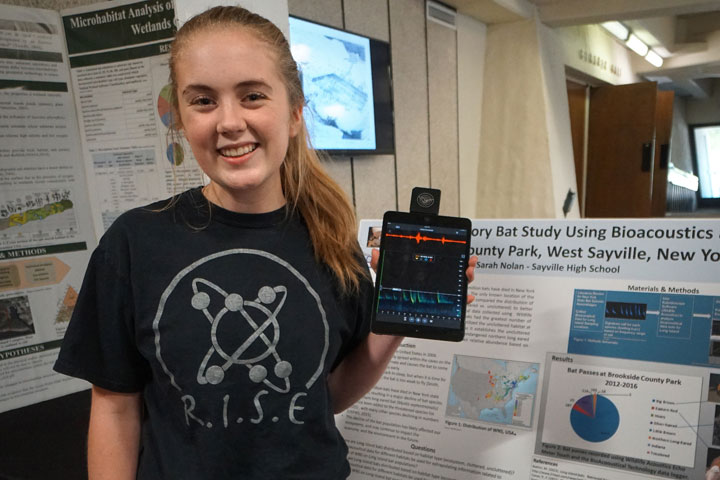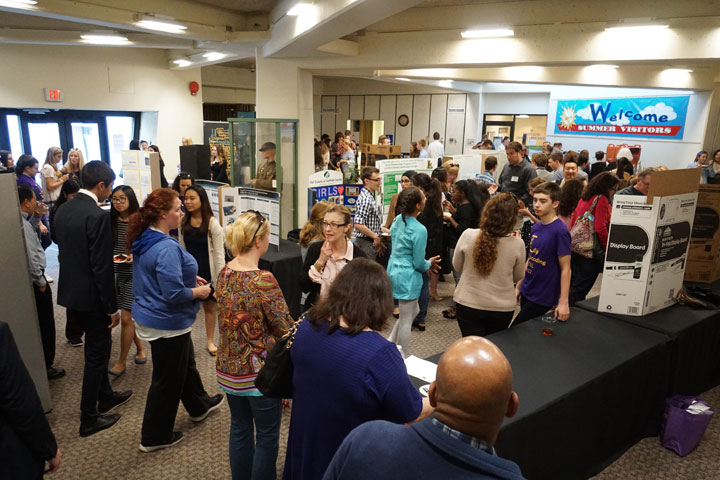2017 Open Space Stewardship Celebration Honors Environmental Research and Community Outreach Efforts by Local Students
June 16, 2017
 enlarge
enlarge
A student who participated in the Open Space Stewardship Program poses in front of her poster board during the annual Open Space Stewardship Celebration
More than 150 students—along with parents, teachers, and environmental scientists—gathered at the U.S. Department of Energy’s Brookhaven National Laboratory on Wednesday, May 31 to celebrate another successful run of Brookhaven’s Open Space Stewardship Program (OSSP) and “A Day in the Life of a River” effort.
Created in 2006, OSSP enables students to conduct environmental research studies in their local communities. The program helps students foster a sense of ownership and responsibility for open space within their neighborhoods. This year, 30 school districts participated in the OSSP.
A Day in the Life of a River is a newer program—founded in 2012—in which students spend one day investigating aquatic life, biodiversity, water chemistry, tides, and other parameters at a local river. At its start, A Day in the Life of a River focused solely on the Carmans River in the Town of Brookhaven, but 10 rivers have been added to the program over the past five years. More than 2,200 students and 100 teachers from 40 school districts participated this year.
Participants in Brookhaven’s OSSP and A Day in the Life of a River are invited back to the lab at the end of every school year to discuss their research findings. This year’s event was bustling as students set up posters in the Lab’s Berkner Hall and discussed local environmental issues with the environmental science community.
Quentin Wheeler, President of SUNY College of Forestry and Environmental Science, was the guest speaker and focused on the importance of biodiversity in our environment.
 enlarge
enlarge
This year's Open Space Stewardship Celebration was bustling as students presented their research in Brookhaven Lab's Berkner Hall and discussed local environmental issues with the environmental science community.
The annual Open Space Stewardship celebration is not a competition; it’s intended to foster discussions of science research and community outreach. This dynamic echoes the program’s goal of getting students involved in science research, nature, and their local communities. The celebration creates an interface between students, government agencies, and elected officials through student presentation of data and emerging issues.
“The idea behind the OSSP was to work with local school districts to get teachers and kids outside and in touch with the open environment,” said Mel Morris, Special Projects Manager at the Office of Educational Programs at Brookhaven Lab.
Students from upper elementary school to high school are involved in the OSSP. Their projects are incredibly diverse, and some of the high school projects are highly sophisticated. This year, students were able to work with Brookhaven’s National Synchrotron Light Source II, a DOE Office of Science User Facility, to study the accumulation of heavy metals in clams.
“We want students to be conducting citizen science and authentic research,” Morris said, emphasizing the fact that the OSSP is not for cookie-cutter science projects.
In past years, students from the Patchogue-Medford School District were able to convince their town board to designate 100 acres of land as a nature preserve based on their OSSP research. Students from the William Floyd school district discovered a new species of insect using DNA barcoding.
The OSSP and A Day in the Life of a River program run throughout the school year. For more information, contact Mel Morris at mmorris@bnl.gov.
2017-12264 | INT/EXT | Newsroom









